|


by Red Collie
from
CropCircleConnector Website
English crop pictures have always
concerned themselves with various aspects of astronomy in our solar
system.
That makes perfect sense, if such messages are being sent to
us across vast spans of time, from another human-like culture who
lived on Earth in the distant past. What else would two such
disparate cultures such as theirs and ours (who might not share a
common written or spoken language) have in common, except for
science, mathematics or astronomy?
For example, crop pictures from the year 1994 showed many schematic
diagrams concerning the impact of
Comet Shoemaker-Levy on planet
Jupiter (see Kris Sherwood,
www.cropcircleconnector.com/Millennium/scorpiushour.html).
Likewise, crop pictures from the year
1995 showed the unexpected outburst and break-up of
Comet 73P Schwassman-Wachmann near
Earth.
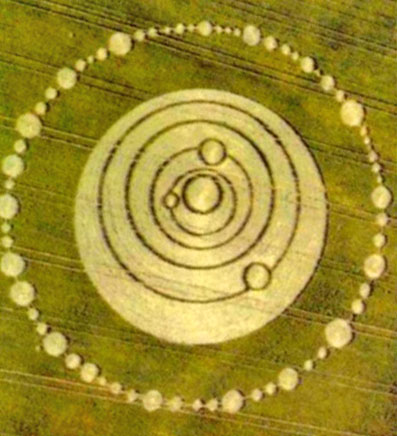
(click above image or see
www.cropcircleconnector.com/anasazi/longwoodwarrren2007.html)
In the latter case, news about break-up
that comet appeared in English fields three months before
professional astronomers on Earth learned of the same event.
Here I will report on how the recent outburst of Comet 17P Holmes
was illustrated schematically in many different crop pictures from
the summer of 2005, over two years ago. Yet because we did not know
in advance that such a comet would explode, most of those pictures
remained un-interpretable until now. Many of us could guess that
"something astronomical" would explode, but we did not know what.
It would be impossible for any ordinary
human faker to construct so many pictures of the future, two years
in advance, especially since no one knew if or when Comet Holmes
would explode (its last time was back in 1892).
An obscure
comet suddenly "outburst" or
exploded on October 25, 2007 in the constellation Perseus
Two weeks ago, astronomers all over the world became very excited to
learn that an obscure comet known as "17P Holmes" had suddenly
outburst or exploded far out in space between the orbits of Mars and
Jupiter:
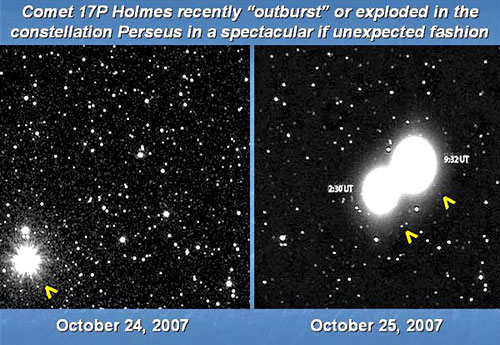
Over the space of just one day from
October 24 to October 25, 2007, that comet changed from being a dim,
almost unobservable object to being the subject of everyone's
attention. It could be seen with the naked eye even in big cities
such as London or Chicago. Comet Holmes was located in the
constellation Perseus when it exploded, and not far from a bright
star called alpha-Perseus or Mirfak.
Many different crop pictures from 2005 show in retrospect what
appears to be an "exploding comet"
Modern crop pictures often concern themselves with comets and their
strange behaviors. Could the recent outburst of Comet 17P Holmes
have been shown in English crop pictures from the summer of 2007, or
from any other summer over the past few years? Upon careful study, I
found that few if any crop pictures from the years 2007, 2006, 2004
or 2003 could possibly be interpreted retrospectively in terms of an
"exploding comet". Yet literally dozens of crop pictures from the
year 2005 could be so interpreted, in a fairly clear and obvious
fashion.
One of the most obvious examples is
shown below, in the case of a huge crop picture that appeared at
Garsington on July 15, 2005:
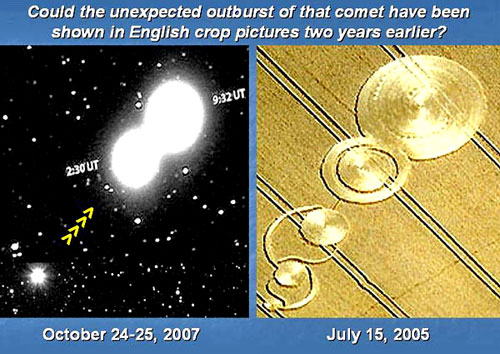
Three more examples from the summer of
2005 are given below, in the cases of Lane End Down, Collingbourne
or Ridgeway which appeared in July or early August.
All of these
seem to show an "exploding comet without a tail":

Stars surrounding
Comet Holmes during its outburst in 2007
closely resemble
"stars" in a crop picture from Lane End Down in 2005
The idea of comets was quite topical in
2005.
For example, one day before an exploding comet was shown at
Lane End Down on July 10, another crop picture on July 9 at Silbury
illustrated the impact of a NASA space probe with Comet Tempel. Some
of us might have therefore associated the exploding astronomical
object shown at Lane End Down with a comet, if anyone had known at
the time that actual comets could really explode! Instead, most
people called that crop picture "the mace", following some kind of
medieval imagery.
When studied in retrospect, the most obvious thing that Lane End
Down was trying to tell us, two years ago, is where in space Comet
Holmes would soon explode:
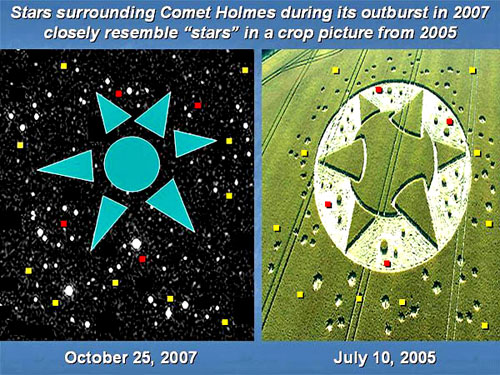
Thus if we compare real stars from the
constellation Perseus with "crop stars" as shown in the halo (white)
or surrounding regions (green) of Lane End Down, we find a pretty
good match as noted above, using red or yellow squares.
For a more
detailed comparison, see Appendix 1 below.
The appearance of "stars" in crop pictures is nothing new. Indeed,
another crop picture from 1994 showed many stars from the
constellation Cetus, in order to portray a triple conjunction of
Mars, Jupiter and Saturn in that constellation six years later.

Precise
stellar locations along the cometary path of outburst in 2007
also appeared in 2005 crop pictures from Germany
Now quite remarkably, to people who might imagine that modern crop
pictures are just an English phenomenon, certain aspects of the
recent outburst of Comet Holmes were also shown in Germany, at the
same time as Lane End Down in England.
Thus, several precise stellar locations
along the cometary path of outburst in 2007 were depicted in German
crop pictures from July 2005, although no one knew at the time what
those strange symbols meant:
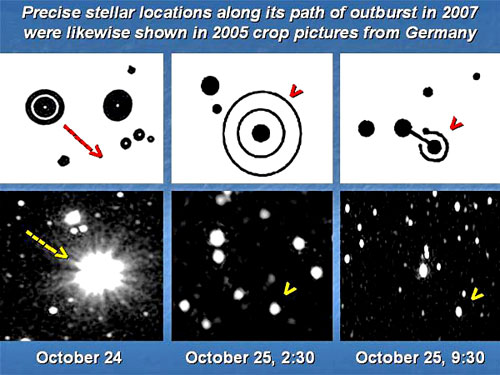
In addition to the three examples shown
above, several other star patterns or asterisms near the site of
cometary outburst were shown in Germany 2005, that I do not have
space here to reproduce.
I was literally amazed to see so much
detail of faint stars in Perseus near that comet, two years in
advance.
Wayland's Smithy on August 9, 2005
gave its own date of appearance plus a
second date of November 21, 2007
To close the 2005 crop season, a spectacular Mayan Sunstone picture
appeared at Wayland's Smithy on August 9. Everyone knew that
something important had just happened, but it was hard to figure out
what that picture was trying to tell us?
It showed 20 Mayan symbols for "time"
around its outer perimeter, along with two binary-hexadecimal codes
as "13-10-7" or "14-5-11" in its central parts:

Jaime Maussan said at the time:
"These are dates! Something is going
to happen then."
Indeed, but how to decode such dates
precisely? And what might they signify?
After some effort, it finally became clear in August 2007 that both
dates should be read in terms of an ancient Olmec-Mayan calendar,
that uses astronomical cycles of Venus and the Sun to keep time.
That was why, for example, Wayland's Smithy showed a "crescent" at
its very centre: because crescent Venus was high and bright in the
English sky on August 9, 2005, just after sunset. That was also why
Wayland's Smithy showed 20 outer symbols for "time", because the
Mayans kept 20 days within any month.
Now in order to decode those dates with precision, first we need to
know exactly on which days of our modern calendar, their ancient
Sun-Venus calendar might begin or end? In order to accomplish that
task, previously I studied a large number of crop pictures from the
years 1994 to 2007. I was thereby able to conclude that their
ancient Sun-Venus calendar began on April 10, 1961 and will end on
March 28, 2013, relative to dates within our modern Julian-Gregorian
calendar. Each of those start-end dates represents a Sun-Venus
conjunction, of which there are 65 in total over the entire period,
lasting 18,980 days or almost 52 years.
Although this scheme might seem strange to modern humans, who use
digital clocks to keep time, it could seem quite straightforward and
logical to other people living in another culture from ours, if they
were to use such a calendar daily. Furthermore, if modern crop
pictures are coming to us from the distant past, when a Sun-Venus
calendar was use across many parts of central America or Europe,
then it makes perfect sense!
With such information in hand, we can now decode both of the
binary-hexadecimal dates shown at Wayland's Smithy:
13-10-7 = 13/16 + 10/16x16 +
7/16x16x16 = 0.81250 + 0.03906 + 0.00171 = 0.85327
14-5-11 = 14/16 + 5/16x16 + 11/16x16x16 = 0.87500 + 0.01953
+ 0.00269 = 0.89722
Thus 0.85327 x 18,980 = 16,195 days = 44 years and 124 days,
while 0.89722 x 18,980 = 17,029 days = 46 years and 227
days.
Our first date is therefore April 10, 1961 + 44 years and
124 days = August 11, 2005 (plus or minus 2 days).
Our second date is likewise April 10, 1961 + 46 years and
227 days = November 22, 2007 (plus or minus 2 days).
The calculated difference between such
binary-hexadecimal dates also seems informative:
14-5-11 minus 13-10-7 = 0-11-4 =
11/16x16 + 4/16x16x16 = 0.04297 + 0.00098 = 0.04395
Hence 0.04395 x 18,980 = 834 days = 2 years and 103.5 days.
So August 9, 2005 + 2 years and 103.5 days = November 20.5,
2007.
In summary, the first date from
Wayland's Smithy was simply the day when it appeared or August 9,
2005. It was provided so that we might have an easy check on our
calculations.
But what about the second date of November 21, 2007:
what could it signify?
November 21,
2007 will be when the newly-exploded Comet Holmes
conjuncts a bright star Mirfak in Perseus
The answer to that question remained unknown until a few weeks ago,
when Comet Holmes suddenly exploded in the constellation Perseus on
October 25, 2007.
While studying the near-future path of that comet
through Earth's sky, I noticed that it would conjunct (or join very
closely) with a very bright star Mirfak in Perseus on November 21,
2007:
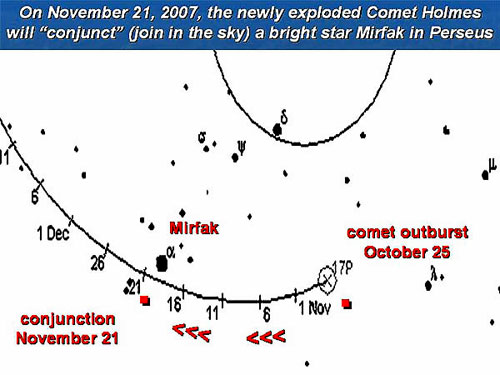
Two symbols for astronomical conjunction
had actually appeared in crops in Germany, at about the same time as
Wayland's Smithy in the summer of 2005, but no one made any
connection to what would happen two years later:
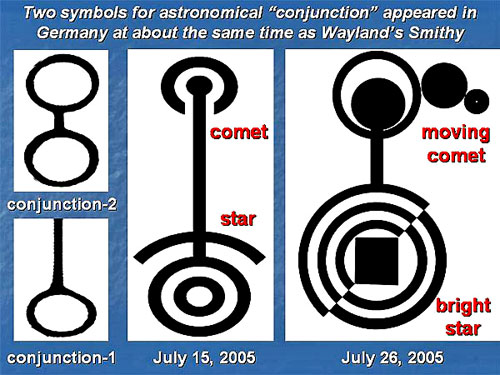
How long will Comet Holmes remain
bright?
This essay began by showing the crop picture of an "exploding
comet" from Garsington on July 15, 2005 (see above). Now when
you look more closely, the largest circle in that crop picture
seems to contain a secondary spiral or code that has been laid
on top of already flattened crop:

If we consider that each "raised
node" in that spiral represents "one day", beginning with
October 25 on the inside and continuing outward to later dates,
then we find that such a spiral completes one full turn by
November 21, 2007. But that is when Comet Holmes will conjunct
with Mirfak!
At other dates past November 21, those raised nodes first taper
off, then get stronger around the end of November. Later they
taper off again after December 8.
It will be interesting to see
how the real Comet Holmes behaves over the next month.
Why would those crop artists have decided to show so many
detailed pictures concerning the 2007 outburst of Comet Holmes,
over two years ago in the summer of 2005?
The reader by this point may have reached a state of amazement,
or perhaps disbelief. How can such incredible things be true?
Surely two old men, after leaving the pub late at night, are
making such patterns with a board and rope? (I am only joking.)
More seriously, who might those crop artists be? And what kinds
of advanced technology might they possess? Experienced
researchers continue to hold many different opinions concerning
such matters. Most of those opinions should be respected. After
all, if crop-circle research has not taught us tolerance and
respect, what have we learned?
But for simplicity, I have
summarized my own personal views below:
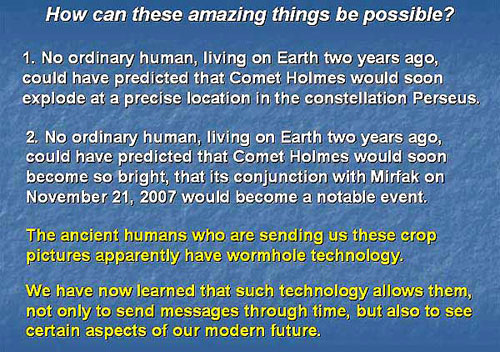
By sending us many detailed pictures
of the outburst of Comet Holmes, over two years before it
happened, those crop artists have clearly demonstrated that they
can predict certain aspects of our modern future here on Earth:
and that may be the most important point. Indeed,
we have only
five years left now until an end to the Olmec-Mayan Long Count
calendar in 2012 (on a winter solstice).
What might happen then,
if anything?
Another crop picture from Crabwood 2002 told us in plain
English:
"Much pain but still time".
That was five years ago.
How much time do we have left?
Despite all of the evidence shown here, I would still like to
think that we have free will in human, non-astronomical affairs.
For example, if all human activities were pre-determined and
invariant, why would they send us crop pictures at all?
And unless such crop pictures were destined to be taken
seriously soon by a large number of people on Earth, why would
they continue to send them?
Was the outburst of Comet Holmes a fulfillment of Hopi
prophecy?
As shown in many sky photographs above or elsewhere, Comet
Holmes after its recent outburst showed a bright, blue-green
halo or coma. Most observers called it a "new star in Perseus".
There is apparently a
Hopi prophecy which says:
"a new blue star will suddenly
appear in our sky, just before the end of one age and the
beginning of another"
I am grateful to Rod Bearcloud at
www.starnationgallery.com/articles.html for reminding me of
the importance of native ways.
Some Christian prophecies are also astronomical: for example,
the prediction of an aurora borealis in Europe just before World
War II (the second prophecy of Fatima). Malachi Martin, before
he died, noted that the third prophecy of Fatima could similarly
be astronomical.
What do modern crop
pictures have to say about 2012?
What do modern crop pictures have to say about the year 2012?
Will there be a big disaster in December? Or could that date be
purely harmless and calendrical, just as we saw recently for
another crop-predicted date of August 18, 2007?
West Overton of July 1996 showed a series of astronomical rays
emerging from our galactic centre, at the time of a solar
eclipse (presumably December 21, 2012) and at a time when
another comet will appear in our skies. Wayland's Smithy of July
2006 later showed more of those same rays, emerging from our
galactic centre at intervals of roughly 5000 years. That is
really not much to go on! We will have to wait for more
information in future seasons, before we can say anything
definite about the year 2012.
Nevertheless, such crop-based messages should be a major
priority for every government on Earth, if for no other reason
than because the crop artists (who make them) seem to know
certain aspects of our planetary future.
Appendix 1.
Detailed comparison of "crop stars"
in Lane End Down of July 10, 2005
with real stars at the sky location
of Comet Holmes in Perseus on October 25, 2007
When studied in close detail, the match between real stars in
Perseus at the sky location where Comet Holmes exploded, and "crop
stars" which were shown two years earlier at Lane End Down,
surrounding an "exploding comet", seems fair but not perfect:
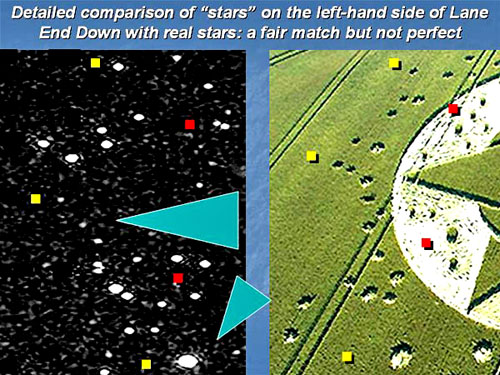
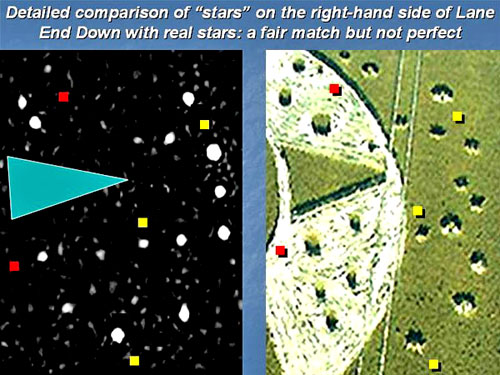
There could be three reasons for such
slight discrepancies:
-
The sky map of those crop
artists may be slightly different from ours, due perhaps
to a long passage of time
-
Another sky location in
Perseus should have been selected (but I was unable to
find any)
-
Comet Holmes will outburst
soon for a second time (in 1892, it outburst for a
second time 75 days after the first)
Appendix 2.
Prediction of the outburst date as
October 24-25, 2007 by means of specific planetary alignments
Wayland's Smithy on August 9, 2005 seemingly predicted when Comet
Holmes would conjunct with Mirfak; but were there any other crop
pictures from the year 2005 that predicted when Comet Holmes would
explode? Yes, two pictures of that kind did appear in close
proximity to an "exploding comet" at Garsington on July 15-16, 2005.
Yet they gave their messages in such a cryptic fashion, that nobody
at the time could possibly have understood what they were trying to
say!
When studied in retrospect, those two pictures seemingly said:
"The outburst will happen when
Mercury is in conjunction with the Sun, and when six heavenly
bodies are aligned in a semi-square position at 45 degrees to
one another."
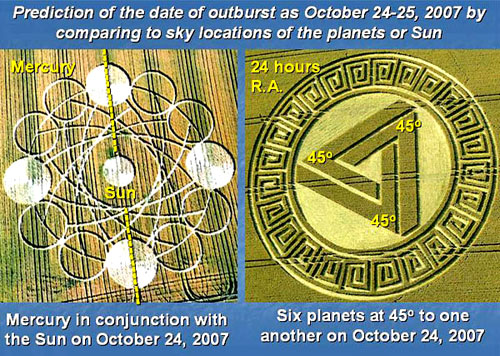
On the left
above, we can see a four-lobed representation of Mercury in its
yearly orbit about our Sun.
On October 24,
2007, Mercury entered into conjunction with the Sun as seen from
Earth (yellow dashed line)
On the right above, we can see an outer
perimeter with 24 Mayan symbols for time.
In this case, those
symbols mean "24 hours of Right Ascension" (an astronomical
coordinate). Then at the centre of the same picture, we can see
three overlapping "V" shaped symbols. Those are called semi-square
symbols in astronomy.
Each means that two planets will be aligned in
our sky at 45 degrees to one another. And since three "V" shaped
symbols were shown in total, the overall crop picture means that 2 x
3 = 6 planets or the Sun will lie at 45 degrees to one another in
Earth's sky.
Now if we calculate Right Ascension values for the date of October
24-25, 2007 when Comet Holmes actually exploded, we find that six
major planets or the Sun were indeed aligned on that date at 45
degree angles to one another in Earth's sky:
Table 1. Astronomical R.A. values and
sky angles for October 24-25, 2007
|
Jupiter |
17 09 |
3 hours ahead |
45 degrees ahead |
|
Sun |
13 56 |
0 hours |
0 degrees |
|
Mercury
|
13 46 |
0 hours
|
0 degrees |
|
Venus |
11 04 |
3 hours behind |
45 degrees
behind |
|
Saturn |
10 33 |
3 hours behind |
45 degrees
behind |
|
Mars |
6 42
|
6 hours behind
|
90 degrees
behind |
|
I am grateful to Rod Bearcloud (www.starnationgallery.com/articles.html)
for bringing these pictures to my attention.
Appendix 3:
Possible cause of the cometary
outburst as rapid spin
Why did Comet Holmes explode to begin with?
Most comets outburst or explode when
they approach the heat of the Sun, but Comet Holmes exploded when it
was heading away from the Sun between the orbits of Mars and
Jupiter.
The best guess of Earth's astronomers
today is that it may have been due to rapid spin:
"The outburst of Comet Holmes was
confounding, because it occurred as the comet was moving away
from the Sun. Dr. Hammergren theorizes that the comet was
spinning at such a rapid rate, that it simply broke apart."
(see
www.chicagotribune.com/services/newspaper/printedition/tuesday/chi-cometnov06,0,2511534.story).
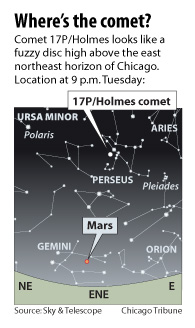
Well, if professional astronomers on
Earth today would like to confirm that tentative hypothesis, they
simply have to study English crops! Not far from where the huge
"exploding comet" was shown at Garsington on July 15, 2005, another
small crop picture showed an expanding comet in rapid spin:

One can see above on the left a "small
comet getting larger" as it spins or spirals rapidly. On the right,
one can see a spectacular spiral of raised crop that was used quite
cleverly to symbolize such a spin motion.
A huge "exploding comet" picture in the
same field on the same day also showed "spin" in one of its
medium-sized circles, which somehow disappeared several days later.
|


















